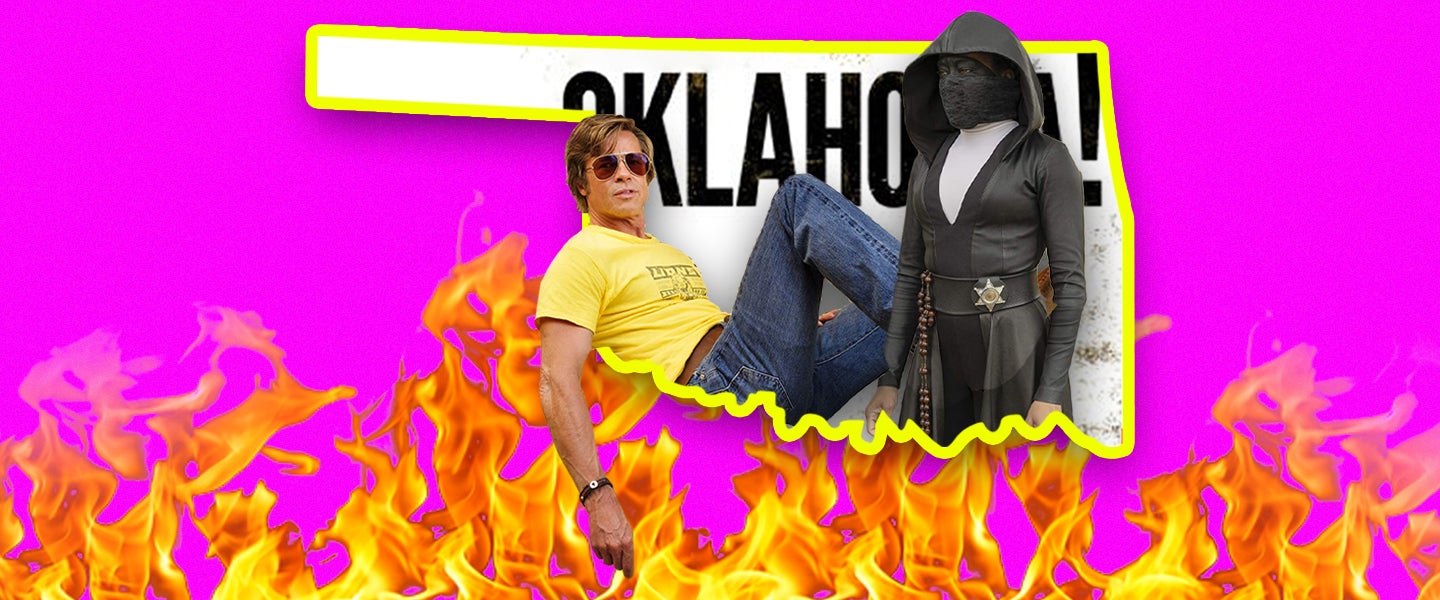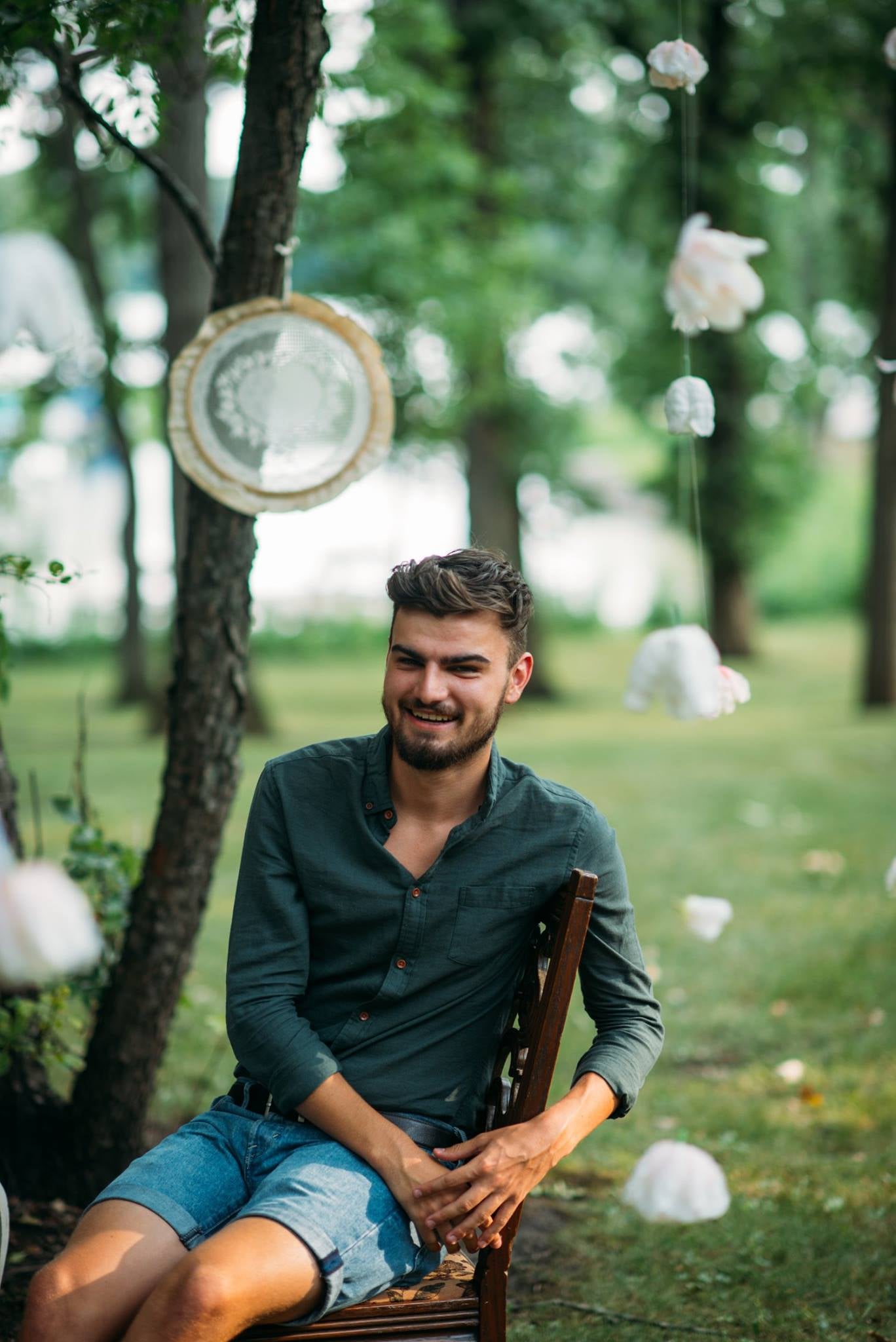As far as I know, there are exactly seven hot people born in Oklahoma, and they’re all having huge years. Most are actors: Brad Pitt in Once Upon a Time in Hollywood, Bill Hader in Barry, Paul Sparks in Ford v. Ferrari and James Marsden in Dead to Me. (I’ll be honest, Tim Blake Nelson’s voice ought to make the cut too.)
The other three are cultural critics who define the elite Oklahoma Hotties list: Out magazine ¡Hola Papi! columnist John Paul Brammer, GQ engagement editor Luke Leifeste and Vulture staff writer Hunter Harris.
These hot seven are known as Oklahoes, and Harris is their Oklah-idol.
What does it mean to be an Oklahoe? “Being an Oklahoe is definitely wearing shorts that are too short. Definitely wearing plaid but, like, plaid tied up,” Harris tells MEL.
An Oklahoe is to the Western state what Euphoria teens are to Southern California. It’s a state of mind, not a list of characteristics. An Oklahoe means being effortlessly cool — and going to local convenience-store chain QuikTrip when you’re home. “QuikTrip is the thing in Oklahoma: getting a drink and making a mixed cocktail with it when you’re underaged. That’s being an Oklahoe,” Harris says.
Harris, who grew up in Tulsa, popularized the term Oklahoe on Twitter this year as her state became an unexpected mainstay of 2019 culture. The musical revival of Oklahoma! brought sex back to blockbuster Broadway, and HBO’s Watchmen offered full-frontal nudity and big blue dicks.
Still, Oklahoma has produced a bounty of aspirational celebrities beyond our Oklahoes. “It’s an honor to be recognized as a Hot Oklahoman, a state that’s been producing hot people for years. Brad Pitt, Reba, Hoda Kotb… need I say more?” Leifeste tells MEL.
Oklahoeing is rooted in the larger Yeehaw Agenda that emerged in the wake of the 2016 presidential election, when media interest grew in the often ignored areas of the country.
“It started out as this sort of weird, forgotten-man narrative. It was like, ‘We forgot farmers, the cowboys, the rural folk, etc.,’” Out magazine’s Brammer, our Oklahoe columnist, tells MEL. “I was told at that time, when I was hired at one of my jobs, ‘Oh, it’s a huge plus that you’re from Oklahoma because that’s when we’re really interested in right now.’”
After the think pieces and profiles on Middle America tapered off, music and fashion took up the reins and rode Yeehaw into the cultural lexicon. Solange Knowles, Kacey Musgraves and Lil Nas X trafficked in country-Western imageries where queerness wasn’t tolerated but encouraged. Levi jeans, assless chaps and leather fringe all took over fashion.
But it’d take Yeehaw hitting Broadway for Oklahoma to emerge with its own sexy status. In April, Rodgers and Hammerstein’s Oklahoma! opened on Broadway and, shortly after, won the Tony Award for Best Revival of a Musical. The reimagining of the 1943 musical adds electric-guitar riffs to old-timey showtunes and “faces that are just a little too close” from its gorgeous leads Damon Daunno and Rebecca Naomi.
Oklahoma! solidified the state’s sex factor that Brad Pitt kicked off in the 1990s. But the musical’s themes are antiquated. Set in the early 1900s, it’s another story about a heterosexual couple whose worlds are keeping them apart. There’s nothing modern and nothing queer in Oklahoma!, even if it’s now so hot it’s serving chili to audiences at intermission.
Just a few months later, the HBO debuted a new adaptation of the comic series Watchmen set in Tulsa and depicting the Sooner State beyond its sweeping plains and tornado alleys. The series opens with the 1921 Tulsa Race Massacre, where residents and businesses of the city’s booming black enclave Greenwood District were mobbed and pillaged. It’s been called “the single worst incident of racial violence in American history.”
Watchmen was praised for bringing a forgotten history to the national stage. “My dad is actually on the board of the Greenwood Cultural Center. The first episode of Watchmen crashed their website,” Harris says.
But the series isn’t just Woke-lahoma, it’s also scorching-hot. Watchmen features the longest and bluest dick in comic book history courtesy of superhero and blue demigod Doctor Manhattan. It’s so big that his ex-lover Laurie Blake, aka Silk Spectre (Jean Smart), is still using a dildo the size of an 13-inch balloon animal.
made this gif of jean smart fondling a giant blue dildo weeks ago; so glad I can finally say to the world "look at this gif of jean smart fondling a giant blue dildo" pic.twitter.com/NgPC6sGSUE
— Kathryn VanArendonk (@kvanaren) November 4, 2019
Thankfully, the big blue D is brought to life by way of a regular Adonis, actor Yahya Abdul-Mateen II, who plays Dr. Manhattan in the series. “I’m really happy to be a part of something that was tasteful, and it wasn’t about the nudity. It wasn’t about being objectified. It was just about a human who was really above notions of shame,” Abdul-Mateen tells Digital Spy.
Because if you wasn’t a fan before! Yahya Abdul-Mateen ii pic.twitter.com/v6iy17VcXm
— Dame Nyc (@NYC_Dame) December 10, 2019
There’s also the sultry voice of Tim Blake Nelson, the hot masked superheroes, a silver, lubed-up lank, a clone couple giving us ass nearly every episode, and James Wolk reminding us never to skip leg day. For our Oklahoes, it’s refreshing to finally get some credit on the national stage for simply being hot.
And this is how Watchmen became my favorite show of 2019 pic.twitter.com/CfRHP7XA1Z
— alex (@alex_abads) December 16, 2019
But not everyone from Oklahoma is hot, the Oklahoes point out. “That feels like revisionist history sort of propelled by sexy Oklahoma!,” Harris says. These things are extremely not hot: Per capita, Oklahoma has the second-highest incarceration rate in the U.S., locking up more women than any other state. It’s also one of the lowest-paying states for teachers. And every single county has gone Republican every presidential election since 1972.
will break my silence on oklahoma! and say: contrary to the production currently on broadway not everyone in the state of oklahoma is hot
— hunter harris (@hunteryharris) April 26, 2019
Anyone who has stayed in Oklahoma is not an Oklahoe. Harris ardently denied Republican Senator Jim Inhofe’s entry into the group. “Important to being an Oklahoe is that you left Oklahoma to hoe somewhere else,” Harris says. “And when you go home to Oklahoma, it’s like, ‘Oh, there’s nothing to Oklahoe here.’”
i share oklahoma's tony win with the five other hot people from oklahoma, all of whom have moved to nyc
— hunter harris (@hunteryharris) June 10, 2019
For Brammer, who moves through the world as a gay and Latinx person, Oklahoes allow him to identify with a part of his heritage he spent his youth wanting to leave. Oklahoma had never felt like part of his identity — until recently.
In May, Brammer brought his close friend Chris from out of town to visit his rural hometown of Cache, Oklahoma, where the population was just under 2,800 in the 2010 Census. Brammer was invited back for Tulsa Pride as a distingushed queer journlast from Oklahoma who had made it out all right. He’d never brought a friend back home for such a personal trip before, and he was taken aback by Chris’ adoration for a landscape he’d never seen as beautiful: mountains, roaming bison, fried catfish, restaurants that serve giant burgers in pie pans.
The personal approval from Chris was a cathartic addition to a year in which Oklahoe had already validated his upbringing. “At some point, you want to hear something nice about it, right? Like you want to believe that the place you’re from has something interesting going on,” Brammer says. “I feel super-proud to be from there, suddenly. I maybe didn’t feel that a while ago.”

